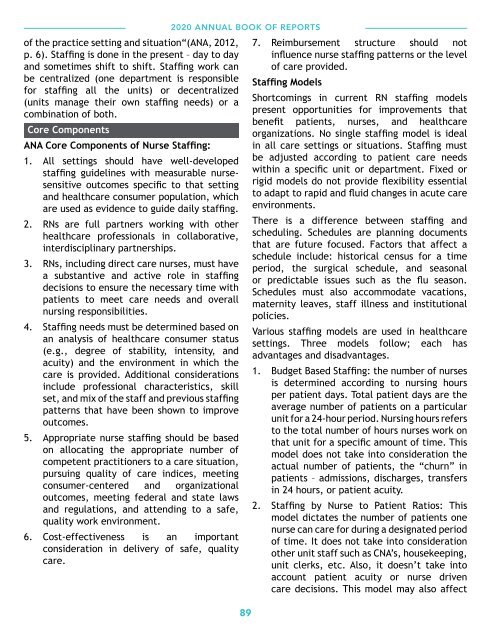ANA-Michigan - 2020 Annual Book of Reports
You also want an ePaper? Increase the reach of your titles
YUMPU automatically turns print PDFs into web optimized ePapers that Google loves.
<strong>of</strong> the practice setting and situation“(<strong>ANA</strong>, 2012,<br />
p. 6). Staffing is done in the present – day to day<br />
and sometimes shift to shift. Staffing work can<br />
be centralized (one department is responsible<br />
for staffing all the units) or decentralized<br />
(units manage their own staffing needs) or a<br />
combination <strong>of</strong> both.<br />
Core Components<br />
<strong>ANA</strong> Core Components <strong>of</strong> Nurse Staffing:<br />
1. All settings should have well-developed<br />
staffing guidelines with measurable nursesensitive<br />
outcomes specific to that setting<br />
and healthcare consumer population, which<br />
are used as evidence to guide daily staffing.<br />
2. RNs are full partners working with other<br />
healthcare pr<strong>of</strong>essionals in collaborative,<br />
interdisciplinary partnerships.<br />
3. RNs, including direct care nurses, must have<br />
a substantive and active role in staffing<br />
decisions to ensure the necessary time with<br />
patients to meet care needs and overall<br />
nursing responsibilities.<br />
4. Staffing needs must be determined based on<br />
an analysis <strong>of</strong> healthcare consumer status<br />
(e.g., degree <strong>of</strong> stability, intensity, and<br />
acuity) and the environment in which the<br />
care is provided. Additional considerations<br />
include pr<strong>of</strong>essional characteristics, skill<br />
set, and mix <strong>of</strong> the staff and previous staffing<br />
patterns that have been shown to improve<br />
outcomes.<br />
5. Appropriate nurse staffing should be based<br />
on allocating the appropriate number <strong>of</strong><br />
competent practitioners to a care situation,<br />
pursuing quality <strong>of</strong> care indices, meeting<br />
consumer-centered and organizational<br />
outcomes, meeting federal and state laws<br />
and regulations, and attending to a safe,<br />
quality work environment.<br />
6. Cost-effectiveness is an important<br />
consideration in delivery <strong>of</strong> safe, quality<br />
care.<br />
<strong>2020</strong> ANNUAL BOOK OF REPORTS<br />
89<br />
7. Reimbursement structure should not<br />
influence nurse staffing patterns or the level<br />
<strong>of</strong> care provided.<br />
Staffing Models<br />
Shortcomings in current RN staffing models<br />
present opportunities for improvements that<br />
benefit patients, nurses, and healthcare<br />
organizations. No single staffing model is ideal<br />
in all care settings or situations. Staffing must<br />
be adjusted according to patient care needs<br />
within a specific unit or department. Fixed or<br />
rigid models do not provide flexibility essential<br />
to adapt to rapid and fluid changes in acute care<br />
environments.<br />
There is a difference between staffing and<br />
scheduling. Schedules are planning documents<br />
that are future focused. Factors that affect a<br />
schedule include: historical census for a time<br />
period, the surgical schedule, and seasonal<br />
or predictable issues such as the flu season.<br />
Schedules must also accommodate vacations,<br />
maternity leaves, staff illness and institutional<br />
policies.<br />
Various staffing models are used in healthcare<br />
settings. Three models follow; each has<br />
advantages and disadvantages.<br />
1. Budget Based Staffing: the number <strong>of</strong> nurses<br />
is determined according to nursing hours<br />
per patient days. Total patient days are the<br />
average number <strong>of</strong> patients on a particular<br />
unit for a 24-hour period. Nursing hours refers<br />
to the total number <strong>of</strong> hours nurses work on<br />
that unit for a specific amount <strong>of</strong> time. This<br />
model does not take into consideration the<br />
actual number <strong>of</strong> patients, the “churn” in<br />
patients – admissions, discharges, transfers<br />
in 24 hours, or patient acuity.<br />
2. Staffing by Nurse to Patient Ratios: This<br />
model dictates the number <strong>of</strong> patients one<br />
nurse can care for during a designated period<br />
<strong>of</strong> time. It does not take into consideration<br />
other unit staff such as CNA’s, housekeeping,<br />
unit clerks, etc. Also, it doesn’t take into<br />
account patient acuity or nurse driven<br />
care decisions. This model may also affect

















